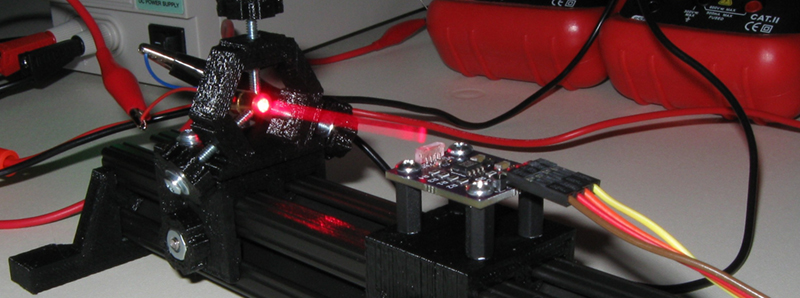Needless to say, we’re fascinated by LEDs, laser diodes, and other blinkies. Although we can get just about any light emitting thing, the data sheets aren’t always accurate or available. For his Hackaday Prize entry, [Ted] is building a device to characterize the efficiency, I/V curve, and optical properties of all the blinkies. It’s a project to make glowy stuff better, and a great entry for the Hackaday Prize.
The inspiration for this project came from two of [Ted]’s projects, one requiring response curves for LEDs, and laser diodes for another. This would give him a graph of optical output vs. current, angular light output distribution, and the lasing threshold for laser diodes. This data isn’t always available in the datasheet, so a homebrew tool is the only option.
The high-level design of this tool is basically a voltmeter and ammeter measuring a glowy diode, producing IV curves and measuring optical output. That takes care of all the measurements except for the purely optical properties of a LED. This is measured by a goniometer, or basically putting the device under test on a carriage attached to a stepper motor and moving it past a fixed optical detector.
If you’re wondering why this device is needed and a simple datasheet is insufficient, check this out. [Ted] measured the efficiency of a Luxeon Z LED, and found the maximum efficiency is right around 10mA. The datasheet for this LED shows a nominal forward current of 500mA, and a maximum of 1000mA. If you just looked at the datasheet, you could easily assume a device powered for years by a coin cell would be impossible. It’s not, and [Ted]’s device gave us this information.





















I wonder if he could practically measure efficiency as a function of die temperature?
I don’t know yet if I can accurately control the temperature of the LEDs to make such measurements, but I think I can at least measure the LED temperature somewhat accurately:
https://hackaday.io/project/12874-automated-ledlaser-diode-analysis-and-modeling/log/45427-temperature-efficiency-hackaday-and-prize-2016#temperature_stuff
“That takes care of all the measurements…” Not quite.
Laser diodes have I-V characteristics are strongly dependent on temperature, which is a problem since even an instantaneous overcurrent (e.g even from ESD!) can permanently damage the optical facets.
And the center wavelength of LED and laser diodes (unless the wavelength is grating stabilized) is dependent not only on junction temperature, but also current.
Yup, but I thought I would keep it simple :)
Laser diodes are just about the most horribly non-linear component I’m aware of, in all dimensions.
Can you explain this a little more? I always thought that lasers and diodes (white excepted) had their wavelength determined by the bandgap of the material and that an electron moving across this band gap sheds a photon at a pretty stable frequency. It’s been a long time since uni so my brain may have faltered on this.
The bandgap may change through temperatur/current
Watch this: https://www.youtube.com/watch?v=ygInJb8o0xs
Read this: http://www.measurement.sk/2002/S3/Bartl.pdf
And now I have the correct word for an ‘angleometer’, goniometer.
Awesome set of projects, [Ted]!
There is a difference between maximum efficiency and maximum brightness. Usually when people by these Luxeon LED’s, they care about brightness. The last paragraph seems to imply that you could run these LED’s with 10 mA instead of 500 mA, however these are completely different use cases.
Who cares if a 1000mA led has its maximum efficiency at 10mA? Its obviously made for high optical output, not for efficiency. Its like buying a Ferrari and then complaining that they don’t tell you the maximum efficiency is at 30km/h… Because now you can buy and drive even more Ferraris at 30km/h for some low fuel consumption project??? What?
Matters to some of us who want maximum battery life…
Thanks for using Ferrari as an allegory to LED droop. :P
But why don’t you use an LED that is designed specifically for low power applications then? Makes no sense to me.
LEDs designed for low-power applications are just made with smaller die area; they show similar efficiency curves. With a given process for making the InGaN LEDs (each company has it’s own “special sauce”, but they are all very similar and the physics is not yet entirely understood), the efficiency peaks at a specific areal current density, and may be reduced by a factor of 2 at the nominal current rating. They call the effect “droop”. So, for smaller LED dice, the efficiency peak is at a correspondingly smaller current (and lower light output). Here’s a curve for a smaller cyan LED designed for 20mA:
https://cdn.hackaday.io/images/9464221470891903480.png
The efficiency peak is at 1mA, again, not at the nominal 20mA. Based on this graph, and assuming the two LEDs were made with the same process (these two were not) you’d get around 50% more light from the Luxeon Z at 10mA than you would from the LED designed for lower power at 10mA. Alternatively, you could run around 10 of the smaller LEDs at around 1mA each to get the same light output. The bottom line is that if you want maximum efficiency (lumens/watt) with 2016 LEDs, you need to drive LEDs below their rated current.
Yes, you pay a hefty premium ($LED cost/lumen) for this “added” efficiency (one Luxeon LED or around 10 smaller ones; the price is about the same), but if your application demands the highest efficiency, you may be willing to make this trade. On at least one of my projects, I am.
Batch variation would be interesting.
#TritiLED project:
Tiny cheap energy harvesting (the LED itself) just to offset the PIC’s quiescent current might be useful?
Batch variation would be interesting.